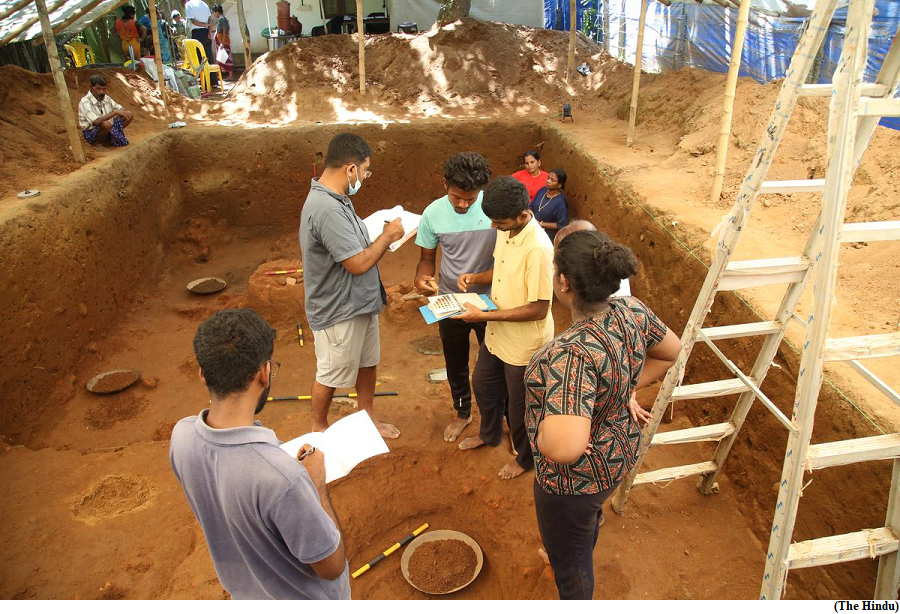No idols, no arms: the Pattanam mystery (GS Paper 1, Culture)

Context:
- In village of Pattanam in central Kerala lies the only multicultural archaeological site on the southwestern coast of the Indian subcontinent.
- Often referred to as the ‘first emporium’ of the Indian Ocean, Muziris; of which Pattanam is part is an example of the Greco-Roman classical age coming into direct contact with an ancient South Indian civilisation.
Key Findings from excavation so far:
- Excavations so far that have unearthed less than 1% of the site, point to a startling fact: there is no evidence that institutionalised religion existed in ancient Pattanam.
- There was certainly no indication of the graded inequality embodied in the caste system that has characterised contemporary Kerala and most of the rest of India.
- The technological, metallurgical, literary, and artistic advances of this phase bear witness to rigorous cultural and commercial exchanges.
Foreign articles:
- The Pattanam excavations have unearthed over 45 lakh sherds (ceramic fragments); these include approximately 1.4 lakh belonging to the littoral regions of the Mediterranean, the River Nile, the Red Sea, the western and eastern Indian Oceans, and the South China Sea.
- Recent findings include the seal of a sphinx, native to the ancient Greek city of Thebes.
Urban centre:
- This wide span of locations confirms the existence of a thriving urban centre from the 5th century B.C. till the 5th century A.D., with its peak phase from 100 B.C. to A.D. 300.
What are the things that did not emerge from Pattanam?
- Pattanam has not chosen to delight archaeologists with idols of gods and goddesses, or the remains of grandiose places of worship.
- This iron-age and post-iron-age site was also bereft of sophisticated weaponry. This is in sharp contrast with some Pattanam-contemporary sites such as Berenike in Egypt and Khor Rori in Oman.
- Were Pattanam residents a peace-loving people who did not harbour religious and caste boundaries?
- The apparent absence of religious and martial remains can only tell that religion and war did not exist as they are known today. It is safe to say there is no evidence of institutionalised religion or caste.
Death rituals:
- Driven by curiosity and the collaborative support of leading scientific institutions such as the University of Oxford and the Centre for Cellular and Molecular Biology in Hyderabad, Pattanam researchers considered another angle of inquiry.
- Given that death and customs associated with mortality are areas that see the biggest religious and caste divides today, what do the Pattanam remains convey about the death rituals of people of that time? The grave remains at the Pattanam site were confined to fragmentary skeleton remains.
- The burials were of a “secondary” nature, where the dead were cremated first and the osseous remains ceremoniously buried later, taphonomic studies and minimal pathological analysis found.
- Large terracotta urn burials and a wide variety of stone monuments abound in the Periyar delta and basin regions, showing the ceremonious nature of the later burial practices. No artefact found indicates any religious customs.
- The genotype results and ancestry analyses of samples point to South Asian, West Asian, and Mediterranean lineages. Indeed, people of widely differing backgrounds were buried the same way, strongly suggesting the prevalence of a secular ethos.
Sangam era link:
- Researchers focusing on Sangam-era literature, connect this observation with the evidence from Sangam sources to point out that the people of the time were secular in every aspect of their highly sophisticated and pluralistic society.
Lesson for modern age:
- Material evidence from the site strengthens the belief that Pattanam society may have lived in harmony with nature, like several indigenous societies did, and not viewed people as separate from nature. This had the positive fallout of living life in an ecologically responsible manner.
- At the very least, such a society did not sanction the exploitation of natural resources that is at the heart of most problems faced by the contemporary world.
- Those who aspire to meaningful alternatives of community living, looking beyond a casteless society towards a closer connect with nature, might find answers in the ground beneath, as more of Muziris (Pattanam) is unearthed.
IACS’s novel compound treats drug-resistant kala-azar infection
(GS Paper 2, Health)
Why in news?
- Experimental work undertaken in mice has shown a novel quinoline derivative to be effective in sharply reducing the load of Leishmania donovani in both the spleen and liver of lab-grown mice.
- The highlight of the work carried out by researchers at the Kolkata-based Indian Association for the Cultivation of Science (IACS) is the potential of the quinoline derivatives to treat drug-resistant leishmaniasis, also called kala-azar (black fever).

Potential of quinoline derivative:
- The quinoline derivative is a potent inhibitor of an enzyme called topoisomerase 1 (LdTop1), which is essential for maintenance of DNA architecture in the parasites; this enzyme is distinct from the one found in humans.
- Poisoning of LdTop1 imparts a significant level of cytotoxicity to both the Leishmania parasites found in gut of sandfly vectors (promastigotes) as well as the form found in the infected humans (amastigotes) of both the wild type and the antimony-resistant isolates without inducing any lethality to human and mice host cells.
Burden of Kala-azar:
- Kala-azar is a vector borne (sandfly) neglected tropical disease caused by the protozoan parasites of the genus leishmania that afflicts the world’s poorest populations in over 90 countries.
- Current annual estimates of kala-azar are about 1,00,000, with more than 95% of cases reported to the World Health Organization (WHO) from India and other tropical countries, most importantly co-infection with HIV, which leads to an immunocompromised state.
- The four States endemic for kala-azar in India are: Bihar (33 districts), Jharkhand (4 districts), West Bengal (11 districts), and Uttar Pradesh (six districts).
- The current treatment regimens against kala-azar use formulations that are toxic and induce high levels of drug-resistance.
- Since the enzyme is essential for parasite replication and transcription from DNA to RNA, inhibition of its activity leads to DNA torsional strain, degradation of the DNA, and ultimately parasitic cell death.
Antileishmanial activity:
- The novel inhibitor targeting the leishmania parasites was identified by screening them against recombinant Leishmania topoisomerase 1 enzyme. In all, 21 derivatives were prepared and evaluated for their antileishmanial activity, and one of them was found to be effective.
- The derivative was found to generate persistent and less reversible DNA breaks compared with the camptothecin inhibitor (discovered in 1966) even after the novel inhibitor was removed from the culture medium leading to enhanced parasite killing.
Way Forward:
- It brings new potential for clinical trials of the quinoline derivative in human hosts infected with drug-resistant leishmaniasis in the rural endemic areas without inducing cytotoxic side effects commonly seen with currently available drugs.
- The further studies are required to test if the novel derivative develops resistance to anti-leishmaniasis therapy by generating point mutations. Also, further studies are needed to test the drug-resistance potential prior to undertaking clinical trials on humans.
The moratorium call on ChatGPT’s successor
(GS Paper 3, Science and Tech)
Why in news?
- Recently, Elon Musk and a group of AI experts signed an open letter calling for a moratorium on developing artificial intelligence (AI) systems that are more powerful than OpenAI’s recently launched large language model (LLM), GPT-4.
- The letter, which at the time of writing had over 1,300 signatories, called on all AI labs to immediately pause, for at least six months, training of any systems more powerful than GPT-4.

What does the letter say?
- Citing one of the Asilomar AI principles on how advances in AI could profoundly impact people’s lives, the Future of Life Institute (FLI) issued letter noted that “AI labs are locked in an out-of-control race to develop and deploy ever more powerful digital minds that no one, not even their creators can understand, predict, or reliably control.”
- The Asilomar AI Principles are one of the earliest sets of AI governing principles laid out at the Beneficial AI 2017 conference hosted by FLI.
What is the context?
- FLI’s open letter comes amid rapid development and deployment of AI technology in several industries. Since OpenAI dropped its generative pre-trained (GPT) chatbot in November, allowing people to freely interact with ChatGPT, there has been a dramatic rise in adoption of AI by many firms.
- The Microsoft-backed chatbot wowed people with its instant, and often apt, replies. It could correct software codes, and explain almost everything on the Internet.
- Roughly three months after its launch, the company allowed developers to integrate ChatGPT’s API with their applications for a fee. Enterprise version of the chatbot, called ChatGPT Plus, has already been integrated by Snapchat, Unreal Engine and Shopify in their applications.
- Such rapid adoption by businesses is heating up competition. Google has taken up the gauntlet. The Alphabet-owned company launched Bard, a version of its Lamda language model.
- In China, Internet giant Baidu has launched Ernie, an AI-powered chatbot than can summarise financial statements.
- Separately, the Massachusetts Institute of Technology’s media lab has developed ELSA, an AI bot that can act as a psychotherapy counsellor. It could potentially be deployed in cognitive behavioural therapy sessions.
Why does FLI’s letter focus on GPT-4?
- In March, OpenAI launched its most advanced LLM yet: GPT-4. This model has been trained on a trillion parameters, compared to ChatGPT’s 175 billion parameters. Having access to such a large dataset allows GPT-4 to learn and understand complex patterns and nuances in natural language far better than its predecessor.
- Unlike ChatGPT, GPT-4 is capable of handling both text and image-based queries. This makes it versatile when compared to other AI language models. Such multi-modal advances give GPT-4 scale to get closer to artificial general intelligence (AGI). That means machine intelligence could be as good as human intelligence.
- A gradual transition gives people, policymakers, and institutions time to understand what’s happening, personally experience the benefits and downsides of these systems, adapt our economy, and to put regulation in place.
What is the view of AI experts?
- AI experts who have signed FLI’s letter approach the rise of LLM-based bots from different vantage points.
- Some see these developments as accelerating humanity towards a doomsday scenario where machines will triumph over humans. Others see these advances as mediocre intelligence that are potentially unreliable.




